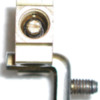It isn't an alignment problem. A bad lower ball joint or a bad outer tie rod can create something like that. More of a bumbsteer feeling though.
I don't think it is the strut either. The strut would be failing in compression to cause that. It would show just driving down the road. When the right would go over a dip the car would vere to the right. It isn't doing that.
Put new rotors on it or do what Boss wrench suggested. Swap the existing left for right and see if it pulls the other way.
What does the wear pattern look like on the pads? Are they glazed? Are there hot spots (high spots) showing on the rotors?
I see two pressure regulators in the picture. The fancy smancy one with the nice knob (I like nice knobs

) and the stock one on the floor? And you said that the pressure measured equal? Then the problem has to be in the clamping power being unequal?



